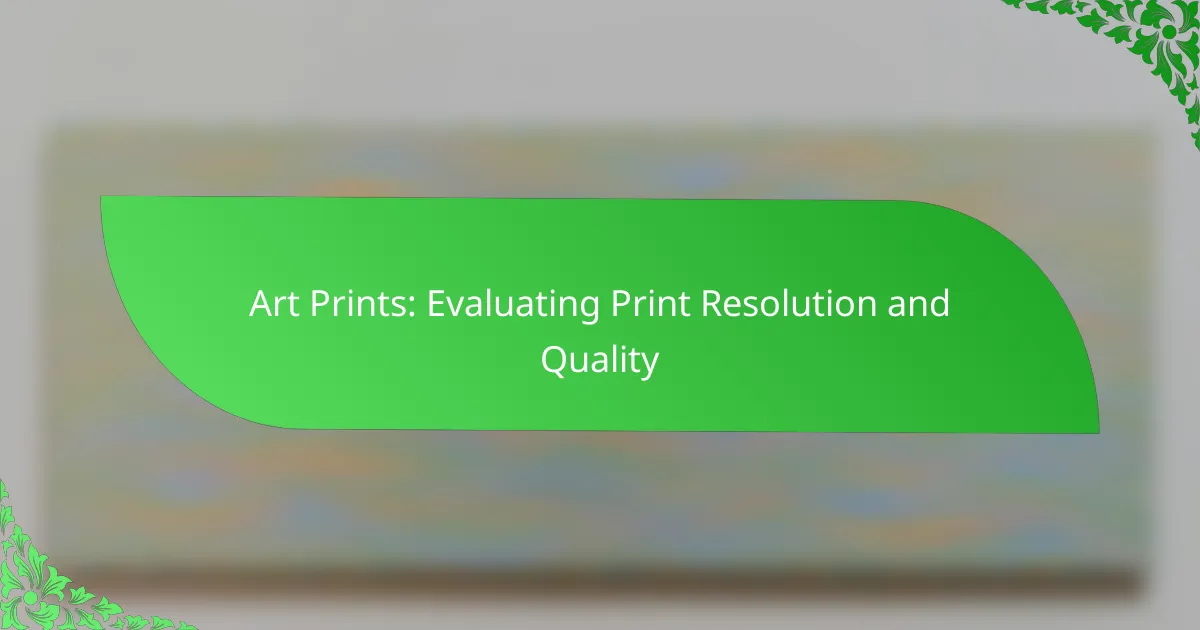When creating art prints, selecting the appropriate print resolution is essential for achieving sharp and detailed images. The quality of the final product is influenced by various factors, including the type of paper, ink quality, and printer technology, all of which contribute to the print’s appearance and durability. Evaluating these aspects, such as resolution and color accuracy, ensures a satisfying visual experience for art enthusiasts and collectors alike.

How to choose the right print resolution for art prints?
Choosing the right print resolution for art prints is crucial for achieving high-quality results. A higher resolution typically results in sharper images, while a lower resolution can lead to pixelation and loss of detail.
Understanding DPI and its impact
DPI, or dots per inch, measures the density of printed dots in an image. Higher DPI values indicate more detail and smoother gradients, which are essential for art prints where color accuracy and clarity are paramount. For instance, a print with 300 DPI will generally look sharper than one with 150 DPI.
When evaluating DPI, consider the viewing distance. Prints viewed from afar can appear acceptable at lower DPI, while close-up views require higher resolutions to maintain quality. This relationship between DPI and viewing distance is key in selecting the right resolution for your art prints.
Recommended DPI for different print sizes
The recommended DPI varies based on the size of the print. For small prints, such as 4×6 inches, a DPI of 300 is ideal to ensure fine detail. For larger prints, such as posters or canvas art, a DPI of 150 to 300 can suffice, depending on the intended viewing distance.
As a general rule, aim for 300 DPI for prints that will be viewed closely, while 150 DPI can work for larger pieces viewed from a distance. This approach balances quality and file size, making it easier to manage your digital files.
Common print resolution standards
Common print resolution standards include 72 DPI for web images, 150 DPI for posters, and 300 DPI for high-quality prints. These standards help guide artists and photographers in preparing their work for various formats and uses.
When preparing files for printing, ensure that your images meet these standards to avoid issues with quality. Always check with your printing service for any specific requirements they may have, as this can vary by provider and medium.

What factors affect the quality of art prints?
The quality of art prints is influenced by several key factors, including paper type, ink quality, and printer technology. Each of these elements plays a crucial role in determining the final appearance, durability, and overall satisfaction of the print.
Paper type and its influence on print quality
The choice of paper significantly impacts the quality of art prints. Different types of paper, such as glossy, matte, or textured, can alter the way colors appear and how details are rendered. For instance, glossy paper tends to enhance color vibrancy, while matte paper offers a more subdued and elegant finish.
When selecting paper, consider the weight and thickness as well. Heavier papers (around 200-300 gsm) generally provide a more premium feel and better durability, which is essential for preserving art prints over time. Always test prints on the chosen paper to ensure the desired outcome.
Ink quality and color accuracy
Ink quality is vital for achieving accurate color reproduction in art prints. High-quality inks, such as pigment-based inks, tend to offer better longevity and resistance to fading compared to dye-based inks. This is particularly important for prints intended for display or sale.
When evaluating ink, look for options that provide a wide color gamut, which allows for more vibrant and true-to-life colors. Additionally, consider the ink’s compatibility with the chosen paper, as this can affect how colors appear once printed.
Printer technology and capabilities
The type of printer used can greatly influence the final quality of art prints. Professional-grade printers, such as inkjet or laser printers with high resolution (typically 2400 dpi or higher), are recommended for producing detailed and vibrant prints. These printers often have advanced features that enhance color accuracy and detail.
Be aware of the printer’s capabilities regarding media handling and ink types. Some printers are designed specifically for fine art printing and can accommodate various paper sizes and types, which is essential for achieving the best results. Always choose a printer that meets your specific printing needs and consider investing in a model known for its reliability and quality.

How to evaluate print quality before purchasing?
To evaluate print quality before purchasing, consider factors such as resolution, color accuracy, and material. High-resolution prints typically offer better detail and clarity, which are essential for a satisfying visual experience.
Examining print samples
Requesting or viewing print samples is crucial for assessing quality. Look for prints that showcase various aspects like color vibrancy, sharpness, and texture. If possible, compare samples side by side to identify differences in quality.
When examining samples, pay attention to the type of paper used and the printing technique, as these can significantly affect the final appearance. For instance, prints on glossy paper may have more vivid colors compared to those on matte finishes.
Reading customer reviews and ratings
Customer reviews and ratings provide valuable insights into the print quality from real users. Look for consistent feedback regarding clarity, color fidelity, and overall satisfaction. High ratings often indicate reliable quality.
Be cautious of reviews that are overly positive or negative without detailed explanations. Focus on comments that discuss specific aspects of the print, such as durability and how well it matches the description provided by the seller.
Checking for certifications and guarantees
Certifications and guarantees can be indicators of print quality and reliability. Look for prints that have been certified by recognized organizations, which often ensure adherence to specific quality standards.
Additionally, consider sellers that offer satisfaction guarantees or return policies. This can provide peace of mind, allowing you to return prints that do not meet your expectations in terms of quality or appearance.

What are the best practices for maintaining art print quality?
To maintain art print quality, it is essential to focus on proper storage, optimal display conditions, and regular cleaning. These practices help preserve the integrity and appearance of prints over time, ensuring they remain vibrant and undamaged.
Proper storage techniques
Store art prints in a cool, dry place away from direct sunlight to prevent fading and deterioration. Use acid-free materials, such as archival boxes or sleeves, to protect prints from moisture and pollutants.
Avoid stacking prints directly on top of each other; instead, use interleaving sheets to prevent scratches and scuffs. Keeping prints flat is preferable, but if rolled, ensure they are loosely rolled with protective paper to avoid creasing.
Optimal display conditions
When displaying art prints, choose locations with stable temperature and humidity levels, ideally around 20°C (68°F) and 40-50% humidity. This helps prevent warping and mold growth.
Use UV-filtering glass or acrylic in frames to reduce exposure to harmful light, which can cause colors to fade. Position prints away from direct sunlight and heat sources to further protect them.
Cleaning and care recommendations
Regularly dust art prints with a soft, dry microfiber cloth to remove particles without scratching the surface. Avoid using cleaning solutions or water directly on the print, as this can lead to damage.
If a print requires deeper cleaning, consult a professional conservator to avoid unintentional harm. For framed pieces, check the frame and matting for signs of wear and replace them if necessary to maintain overall presentation quality.

How does print resolution vary by art style?
Print resolution varies significantly by art style, influencing the quality and detail of the final output. Different styles, such as photography, digital illustrations, and mixed media, have unique requirements that affect how they should be printed to achieve optimal results.
Resolution needs for photography prints
Photography prints typically require higher resolutions to capture intricate details and textures. A common standard is 300 dots per inch (DPI) for high-quality prints, ensuring that images remain sharp and clear, especially in larger formats.
For example, a standard 8×10 inch photo should ideally have a resolution of at least 2400×3000 pixels. Lower resolutions can lead to pixelation, diminishing the overall quality of the print.
Resolution considerations for digital illustrations
Digital illustrations can vary in resolution based on the intended use, but a resolution of 300 DPI is often recommended for print. This ensures that colors and lines are crisp, particularly for detailed artworks.
Artists should consider the size of the final print when determining resolution. For instance, a 12×16 inch illustration should be created at a minimum of 3600×4800 pixels to maintain quality. Using vector graphics can also help, as they can be scaled without losing resolution.
Print resolution for mixed media art
Mixed media art often combines various techniques and materials, which can influence resolution needs. When printing such artworks, a resolution of 300 DPI is advisable to preserve the nuances of different textures and layers.
Artists should also consider the medium used in the original piece. For example, if the artwork includes fine details from watercolor or ink, ensuring high resolution will help capture those subtleties in the print. It’s beneficial to test print at different resolutions to find the best balance between quality and file size.

What are the latest trends in art print technology?
The latest trends in art print technology focus on enhancing print quality and expanding creative possibilities. Innovations in materials and techniques are enabling artists to produce prints with greater detail, durability, and vibrancy.
Advancements in printing materials
Recent advancements in printing materials include the development of eco-friendly inks and high-quality substrates. Artists are increasingly using archival papers and canvas that resist fading and yellowing, ensuring longevity for their prints.
Additionally, the rise of specialty materials, such as metallic and textured papers, allows for unique finishes that can elevate the visual impact of art prints. These materials cater to diverse artistic styles and preferences, enhancing the overall presentation.
Emerging printing techniques
Emerging printing techniques, such as 3D printing and inkjet technology, are revolutionizing the art print landscape. 3D printing enables artists to create tactile, sculptural pieces that blend traditional art with modern technology.
Inkjet printing continues to evolve, with advancements in resolution and color accuracy. Techniques like giclée printing are gaining popularity, as they provide high-quality reproductions that closely match the original artwork.
Future of digital art prints in e-commerce
The future of digital art prints in e-commerce looks promising, with increasing demand for online art sales. Artists are leveraging platforms that allow for direct sales to consumers, bypassing traditional galleries and expanding their reach.
As technology advances, more artists are offering customizable prints, allowing buyers to select sizes, materials, and finishes. This trend not only enhances customer satisfaction but also opens new revenue streams for artists in the digital marketplace.
